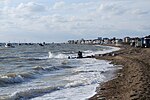North Shoebury
Former civil parishes in EssexPopulated coastal places in EssexSouthend-on-Sea (town)

North Shoebury (once known as Shoebury Parva and Little Shoebury) is a former civil parish and village in the ceremonial county of Essex, England. It is now part of Shoeburyness, a suburb of the city of Southend-on-Sea.
Excerpt from the Wikipedia article North Shoebury (License: CC BY-SA 3.0, Authors, Images).North Shoebury
Frobisher Way, Southend-on-Sea North Shoebury
Geographical coordinates (GPS) Address Nearby Places Show on map
Geographical coordinates (GPS)
| Latitude | Longitude |
|---|---|
| N 51.53989 ° | E 0.78167 ° |
Address
Frobisher Way
SS3 8XA Southend-on-Sea, North Shoebury
England, United Kingdom
Open on Google Maps






